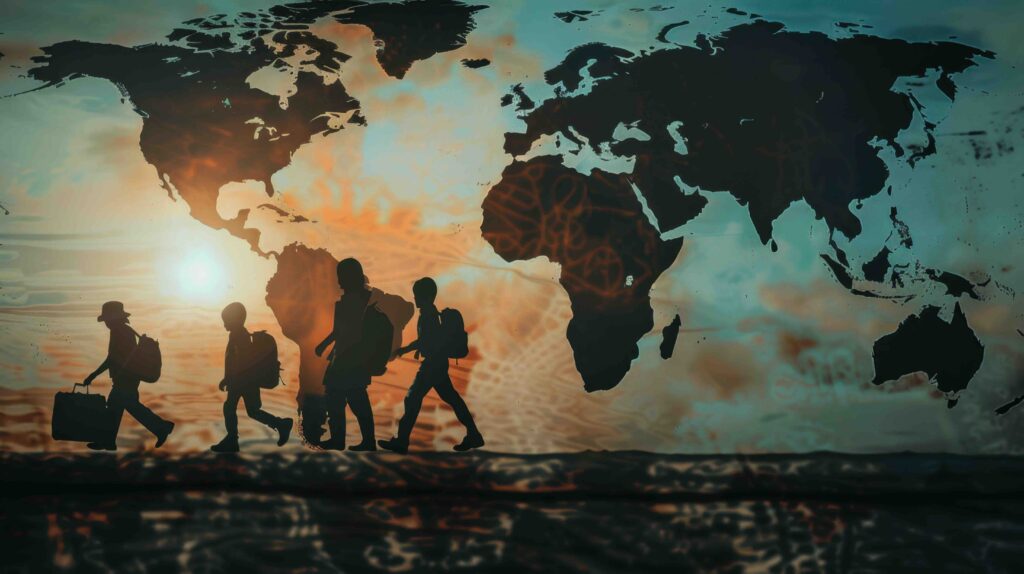Migration has always been part of the human story. But today, more than 110 million people around the world are forcibly displaced due to conflict, climate change, and economic instability. Refugees and migrants face daunting challenges: securing safety, accessing documentation, finding work, and integrating into new communities. In recent years, technology has emerged as a powerful tool to transform how governments, NGOs, and humanitarian organizations respond to these challenges making support systems more efficient, accessible, and human-centered.
1. Digital Identity and Biometric Solutions
One of the greatest hurdles for refugees is the loss of official identification documents. Without an ID, accessing healthcare, education, banking, or even food aid becomes nearly impossible. To address this, organizations like the UNHCR and the World Food Programme have adopted biometric registration systems. Refugees can be identified using fingerprints, iris scans, or digital IDs, reducing fraud and ensuring that aid reaches the right people. Some pilots also use blockchain-based digital identity solutions to create secure, portable IDs that refugees can carry across borders.
2. Mobile Connectivity and Access to Information
Smartphones have become lifelines for displaced people. They connect refugees to family members, provide critical updates about asylum processes, and offer access to legal aid or translation services. Initiatives like Refugee.Info and MigApp (developed by the International Organization for Migration) deliver verified information on migration laws, local services, and safety tips in multiple languages helping refugees navigate unfamiliar systems with more confidence.
3. Blockchain for Aid Distribution
Delivering humanitarian aid efficiently has always been a challenge, especially in conflict zones. Blockchain technology is now being used to make aid distribution more transparent and accountable. For example, the Building Blocks programby the World Food Programme enables refugees to purchase food using blockchain-based vouchers, reducing costs and ensuring funds go directly where intended.
4. AI-Powered Language and Translation Tools
Language barriers are one of the biggest obstacles for migrants and refugees in host countries. AI-powered translation apps and chatbots are bridging this gap. Tools like Tarjimly, a mobile app that connects refugees with volunteer translators, provide real-time language support. These innovations not only ease communication but also help refugees integrate into local communities and access essential services.
5. E-Learning and Digital Skills Training
Education is critical for refugee children and adults, but traditional schooling often isn’t available in camps or transit zones. Tech platforms are filling the gap with online learning programs tailored for displaced populations. Initiatives such as Kiron Open Higher Education provide free digital university-level courses for refugees, while mobile-first platforms deliver vocational and language training to help them prepare for the job market.
6. Remote Work and Employment Platforms
Access to sustainable livelihoods is vital for long-term integration. Digital platforms now connect refugees to freelance and remote work opportunities. Startups like NaTakallam employ displaced people as online language tutors, while other platforms link refugees to global gig-economy opportunities. These tools empower refugees to earn an income regardless of their legal status or location.
7. Data and Predictive Analytics for Humanitarian Planning
Governments and NGOs are increasingly using data analytics and AI to predict migration patterns, plan resource allocation, and respond to crises more effectively. Satellite imagery and predictive models help identify emerging migration hotspots due to conflict or climate events, allowing organizations to act before situations escalate.
8. Mental Health and Wellbeing Support
Beyond physical needs, refugees also face trauma and mental health challenges. Digital platforms now provide teletherapy and mental health support in multiple languages. Apps offering guided counseling, mindfulness exercises, and access to remote professionals are becoming part of humanitarian toolkits, making care more accessible in resource-constrained settings.
The Road Ahead
Technology alone cannot solve the complex challenges of global migration. However, when combined with strong policies, international cooperation, and community-based approaches, it has the power to create more dignified, secure, and inclusive pathways for displaced people.
From digital IDs and blockchain aid systems to AI translators and remote work platforms, these innovations are reshaping how the world responds to one of humanity’s greatest challenges. They reflect a broader truth: technology, when applied with empathy and equity, can turn displacement into opportunity and help refugees not only survive but thrive.
Read more on Tech Gist Africa:
How Technology is Advancing Global Food Security and Reducing Hunger
Global Startup Ecosystems: Key Drivers of Innovation in Emerging Markets
Corporate Innovation: How Major Companies are Fostering a Culture of Disruption
